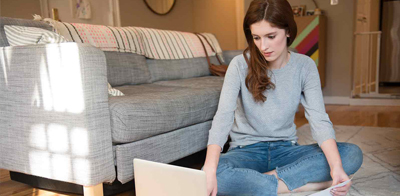
Have you put buying a first (or next) home on the back burner because of debt? Well, there's good news. Contrary to what you may have heard, it is possible to buy a house when you have debt (and still feel confident). Here’s how.
1. Understand your debt-to-income (or DTI) ratio
Your DTI ratio is all of your monthly debt payments divided by your gross monthly income (the amount earned before taxes and other deductions). It’s typically an important part of the home buying process since some lenders require your debt (including your new potential mortgage payments) to make up less than 36% percent of your income. NOTE: Many lenders may be comfortable with a DTI as high as 43%. It depends on your lender and specific situation.
Wondering what your DTI ratio might look like to a potential lender? To calculate it:
- Add together all of your total monthly debt (think: credit card debt payments, car payments, student loan payments, etc.).
- Then add that number to your potential monthly mortgage payment
- Divide the total of those two numbers by your gross monthly income.
So, for example, if your total monthly debt equals $500 and your gross monthly income is $5,000, your lender might qualify you for a mortgage where your monthly mortgage payments are $1,300/month, which would bring your DTI to 36%. ($1,800 divided by $5,000)
If your DTI is high, you could consider consolidating your debts to help improve your chances of qualifying for a mortgage.
2. Consolidate your debt
Debt consolidation is one way to reduce your DTI ratio, and yes, it’s exactly what it sounds like: combining a number of loan payments into one payment at a fixed interest rate. The benefits of consolidating credit card debt or student loans, for example, include:
- You’ll make just one payment a month instead of several
- Your total monthly payment will likely be less
- You could pay less interest over the life of the loan (and/or pay off your debt sooner)
- You could decrease your DTI ratio, which could position you as a more qualified borrower for a home loan
3. You could put less money down and use the rest to pay off debt
Good news: You don’t have to put 20 percent down to buy a home. In fact, many first-time homebuyers put down 5 percent.1 This is largely because first-time buyers have additional existing debt, such as monthly student loan payments. So, the less of your savings you put down, the more you’ll have to put toward paying off your debt. Keep in mind, however, the less money you put down the more your monthly payments will likely be, so it’s all about what’s right for you. Consider the possible scenarios for a potential homebuyer who has a good credit score but also has debt.
He/she has:
- $5,000 gross income each month
- $25,600 in consumer debts (payments are $500 each month)
- $250,000 home price
- $57,600 saved to buy a home (for down payment and closing costs)
|
Scenario 1 |
Scenario 2 |
|
|---|---|---|
| Down payment | 20% down = $50,000 | 10% down = $25,000 |
| Closing costs | $7,600 | $7,000 |
| Loan amount | $200,000 | $225,000 |
| Loan term | 30 years | 30 years |
| Rate and APR (Annual Percentage Rate) NOTE: This is an illustration and not a quote for an actually available rate. | 4.875% (4.927%) | 4.875% (5.179%) |
| Private mortgage insurance, or PMI (if you do not put 20 percent down, you’ll need to pay PMI each month until you reach 20 percent equity in your home) | N/A | $94 per month |
| Total mortgage payment | $1,375 per month (including homeowners insurance and taxes, which vary in all cities and states) | $1,600 per month (including homeowners insurance, taxes and PMI, which vary in all cities and states) |
| Total liabilities each month | $1,375 mortgage payment + $500 consumer debts = $1,875 per month | If you use the remaining $25,600 saved to pay off your debt, you’d only have to worry about the mortgage payment at $1,600 per month |
As you can see in the above scenarios, putting 10 percent down might save $275 each month, which you could use to save for future needs or to pay down debt. The flip side is that a smaller down payment will require you to pay more over the life of the loan. So, ask yourself: What mortgage and down payment can I afford while still saving money and paying off debt(s)?
Most importantly? Do what’s right for you and your financial situation. If buying a home is going to add more financial stress than confidence to your life, wait until you’re ready.
1 "Home Buyer and Seller Generational Trends Report 2017," 2017, National Association of Realtors


